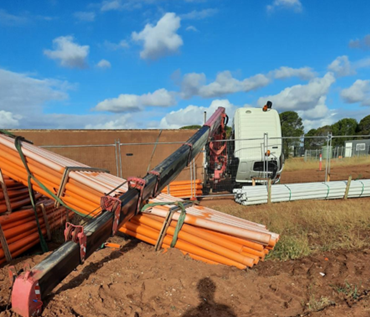SafeWork SA is issuing a safety alert to remind PCBUs that they must not direct or allow a worker to carry out work activities without holding the relevant high risk work licence.
Background
On 15 November 2021 SafeWork SA received notification that a vehicle loading crane overturned during the unloading of a stillage containing electrical conduits.
The investigation found that:
- the truck mounted crane had a lifting capacity greater than 10 metre tonnes (CV)
- multiple synthetic slings were used to lift the stillage that required the worker to consider load size, shape, load weight and centre of gravity (DG)
- the outriggers were not extended
- the crane was overloaded in the stability area of its load chart
- the crane controls were on the driver’s side requiring the operator to jump out of the line of fire
- the operator did not hold a high risk work licence for the classes of work being undertaken (CV and DG).

Managing risks
SafeWork SA reminds workers and persons conducting a business or undertaking (PCBU) that cranage is a high-risk work activity requiring workers to possess the appropriate high risk work licences including crane and dogging.
Only competent, suitable qualified, trained, instructed and supervised workers are to participate in crane operations.
All workers are required to be inducted into the Safe Work Method Statement/Procedures and possess an intimate knowledge of the high-risk work activity before work commences.
Reminder of PCBU obligations
SafeWork SA reminds PCBUs that they must not direct or allow a worker to carry out work activities for which a high risk work licence is required unless they see written evidence provided by the worker that they possess the relevant high risk work licence for that work.
High Risk Work licences are issued on the basis that workers have been trained, assessed and deemed competent to undertake the class of work safely. Workers have a duty to ensure their actions do not put themselves or others at risk of injury or harm whilst undertaking work activities.
SafeWork SA Executive Director, Martyn Campbell reminds PCBUs of their duty to identify high risk work activities and ensure workers hold the appropriate licence.
“High risk work licences were introduced to ensure hazards and risks associates with high risk activities are being managed safely and competently”.
“The worker in this recent incident was very lucky not to have been seriously injured or killed”.
Directing or allowing a worker to carry out high risk work for which a high risk work licence is an offence with penalties ranging from expiation to prosecution.
High Risk Work Licence
An individual must be licensed for a class of high risk work before they carry out that type of work.
A licence to perform High Risk Work is recognised all around Australia as part of a national licensing system and is required for the following kinds of work:
- Crane and hoist operation
- Dogging and rigging work
- Forklift operation
- Pressure equipment operation
- Scaffolding work.
Further information
- HRW classes, training and assessment
- Safe Work Australia: High Risk Work Licensing for Vehicle Loading Cranes
- Safe Work Australia: High Risk Work Licensing for Dogging


